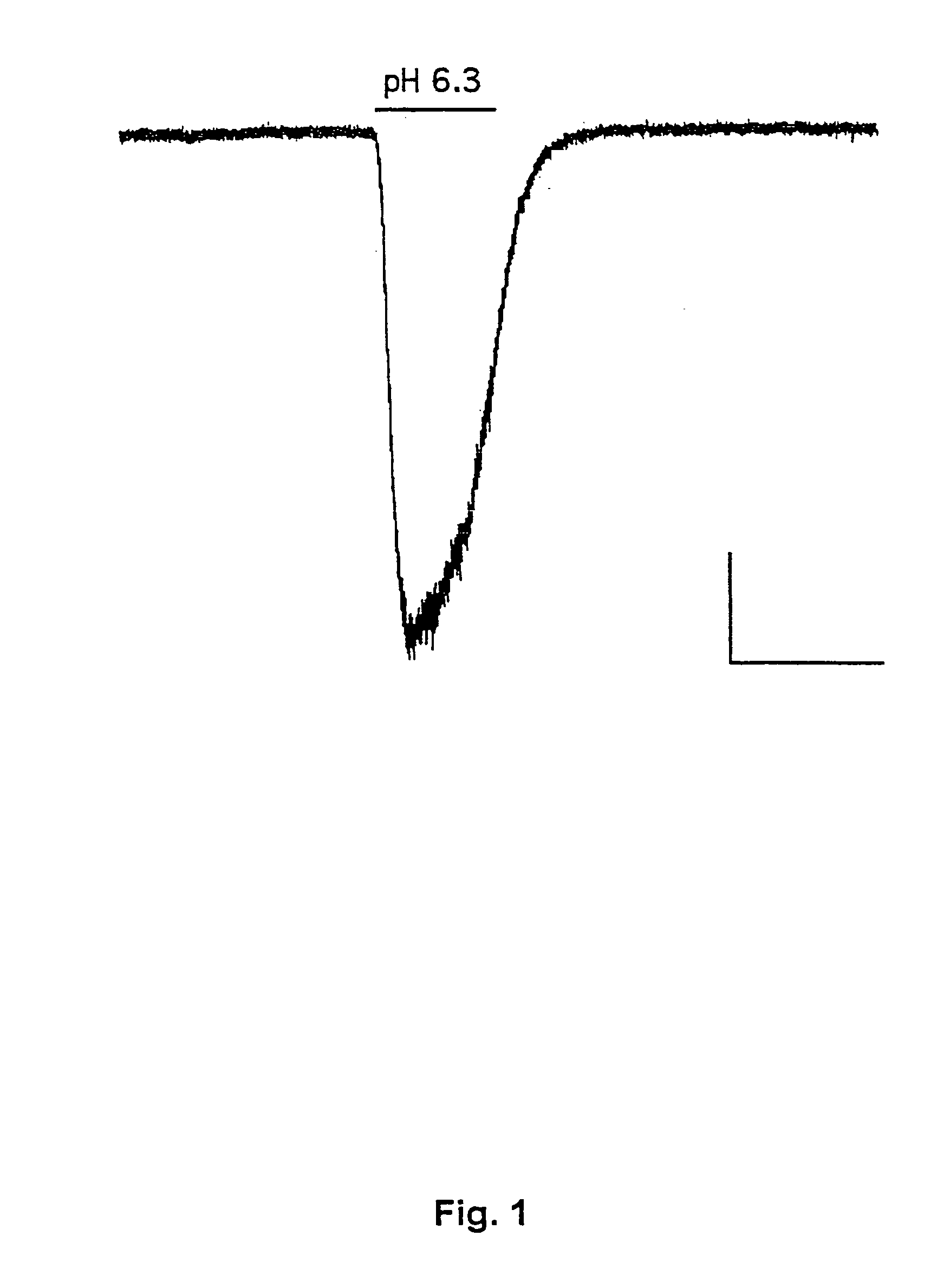Inhibitors of proton-gated cation channels and their use in the treatment of ischaemic disorders
a technology of proton-gated cation channels and inhibitors, which is applied in the direction of biocide, cardiovascular disorders, drug compositions, etc., can solve problems such as adverse effects
- Summary
- Abstract
- Description
- Claims
- Application Information
AI Technical Summary
Benefits of technology
Problems solved by technology
Method used
Image
Examples
example 1
Preparatory Example
[0166]
8-methoxycarbonylmethyl-5-phenyl-6,7,8,9-tetrahydro-1H-pyrrolo-[3,2-h]-isoquinoline-2.3-dione (Compound 1A)
[0167] A suspension of 5-phenyl-6,7,8,9-tetrahydro-1H-pyrrolo[3,2-h]-isoquinoline-2,3-dione (0.278 g), methylbromoacetat (107.35 μl) and potassium carbonate (0.138 g) in methanol (20 ml) was stirred at room temperature for 24 hours. The suspension was partly evaporated and water (20 ml) was added. This afforded a solid precipitate which was collected by filtration.
[0168] In exactly the same manner the following compounds were obtained:
8-(2-propynyl)-5-phenyl-6,7,8,9-tetrahydro-1H-pyrrolo[3,2-h]-isoguinoline-2,3-dione (Compound 1B)
from 5-phenyl-6,7,8,9-tetrahydro-1H-pyrrolo[3,2-h]-isoquinoline-2,3-dione and propargylbromide;
8-cyclopropylmethyl-5-phenyl-6,7,8,9-tetrahydro-1H-pyrrolo[3,2-h]-isoquinoline-2,3-dione (Compound 1C)
from 5-phenyl-6,7,8,9tetrahydro-1H-pyrrolo[3,2-h]-isoquinoline-2,3-dione and cyclopropylbromide; and
8-benzyl-5phenyl-6,7,8...
example 2
Preparatory Example
[0169]
8-methoxycarbonylmethyl-5-phenyl-6,7,8,9-tetrahydro-1H-pyrrolo-[3,2-h]-isoquinoline-2,3-dione-3-oxime (Compound 2A)
[0170] 8-methoxycarbonylmethyl-5-phenyl-6,7,8,9-tetrahydro-1H-pyrrolo-[3,2-h]-isoquinoline-2,3-dione (0.25 g) and hydroxylamine hydrochloride (76 mg) was added with stirring to hot (50° C.) methanol (25 ml). After 2 hours of stirring the reaction mixture was concentrated by evaporation. At room temperature water (20 ml) was added.
[0171] This afforded a solid precipitate of the product as the hydrochloride (90 mg). The free base could be obtained by treatment with carbonate.
[0172] M.p. of the free base 165° C. (decomp).
[0173] In a similar manner the following compounds were prepared from the corresponding diones:
8-(2-propynyl)-5-phenyl-6,7,8,9-tetrahydro-1H-pyrrolo[3,2-h]-isoquinoline-2,3-dione-3-oxime (Compound 2B)
[0174] M.p. 170° C. (decomp.).
8-cyclopropylmethyl-5-phenyl-6,7,8,9-tetrahydro-1H-pyrrolo[3,2-h]-isoquinoline-2,3-dione-3-oxim...
example 3
[0177] This example demonstrates the existence of proton-gated cation channels in cultured mouse cortical neurons, and the effect of Amiloride on these neurons.
[0178] The following experiments were performed in voltage-or current clamp using conventional whole cell patch clamp methods [Hamill O P, Marty A, Neher E, Sakmann B and Sigworth F J: Improved patch-clamp techniques for high-resolution current recording from cells and cell-free membrane patches; Pflüqers Arch. 1981 39 85-100]. The following salt solutions were used (where nothing else stated, the chemicals are available from Sigma): NaCl (140 mM), KCl (4 mM), CaCl2 (2 mM), MgCl2 (1 mM), Sucrose (30 mM; Available from Fluka Chemie, Buchs, Switzerland), HEPES (10 mM, pH 6-7.4). Solutions with pH2+ contained 3 mM MgCl2. Solutions with no added Na+ contained 140 mM N-methyl-D-glucamine. For voltage clamp experiments, the extracellular solutions were added Tetrodotoxin (0.0003 mM; Available from Alomone Labs,...
PUM
| Property | Measurement | Unit |
|---|---|---|
| Flow rate | aaaaa | aaaaa |
Abstract
Description
Claims
Application Information
 Login to View More
Login to View More - R&D
- Intellectual Property
- Life Sciences
- Materials
- Tech Scout
- Unparalleled Data Quality
- Higher Quality Content
- 60% Fewer Hallucinations
Browse by: Latest US Patents, China's latest patents, Technical Efficacy Thesaurus, Application Domain, Technology Topic, Popular Technical Reports.
© 2025 PatSnap. All rights reserved.Legal|Privacy policy|Modern Slavery Act Transparency Statement|Sitemap|About US| Contact US: help@patsnap.com



